
These were the “smoke wagons,” “street howitzers” and repeaters that tamed the American West.
What were the guns that won the West?
- Colt Paterson
- Henry 1860
- Colt Single-Action Army
- Colt 1851 Navy
- 1873 Springfield Trapdoor
- Winchester Model 1873
- Double-Barreled Shotgun
- Sharps Rifle
- Smith & Wesson Model 3
- Winchester 1886
Was there one gun that won the West?
Certainly, in popular history, the Winchester Model 1873 is given this distinction. While the trusty ol' lever-action shooting iron more than earned its stripes in military conflicts, range wars and protecting the Back 40, it far from single-handedly tamed the vast American frontier.
In reality, no one gun can make the claim. It was a vast arsenal of different revolvers and rifles and shotguns of every conceivable design, make and model that carved this nation from coastline to coastline.
Even if there was no single gun that won the West, there are certainly some six-shooters, repeaters and other great guns that more than pulled their share of the weight during this era. With that in mind, here are the 10 guns you have to know from the Old West. While there were many other firearms that left their mark on this time, these were among the most important.
Colt Paterson
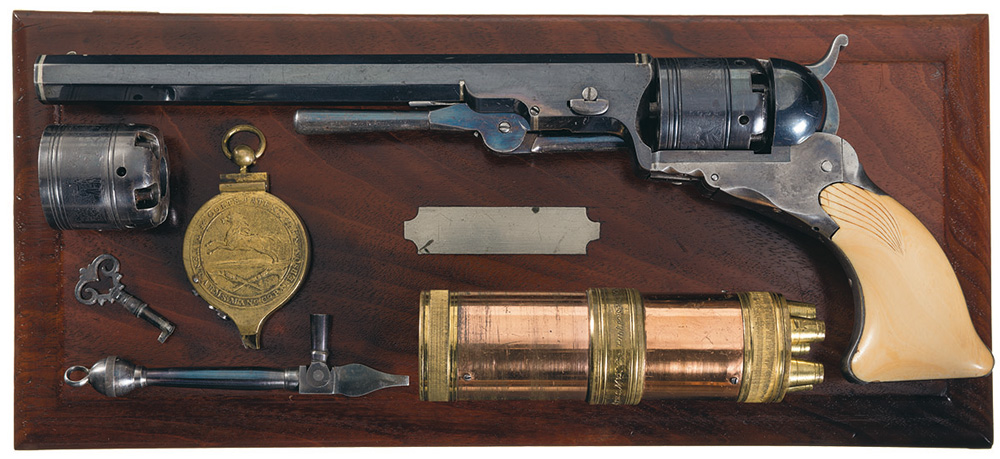
While not as storied as some Colts, the first commercially successful repeating firearm, nonetheless, left its mark on the West. Patented in 1836 and produced until 1842, just a little more than 2,000 of the cap-and-ball revolvers were manufactured. Despite their limited numbers, the Colt Patersons found their way into a number of definitive conflicts in the mid-1800s.
Among the most storied was the Battle of Bandera Pass, which marked the turning point of the Texas-Indian wars. In the early 1840s fight, 50 or so Texas Rangers, led by legendary Captain John “Jack” Hays, routed a vastly superior force of Comanche, thanks in large part to their five-shot Colt Patersons.
This wasn’t the only time Hays prevailed against overwhelming odds due to the revolver. Previously in the Battle of Walker Creek and his Big Fight at Enchantment Rock, the Paterson proved its worth. While the revolver came in many calibers, the .36-caliber No. 5 became known as the “Texas Patterson” for its use by the Rangers.
Henry 1860
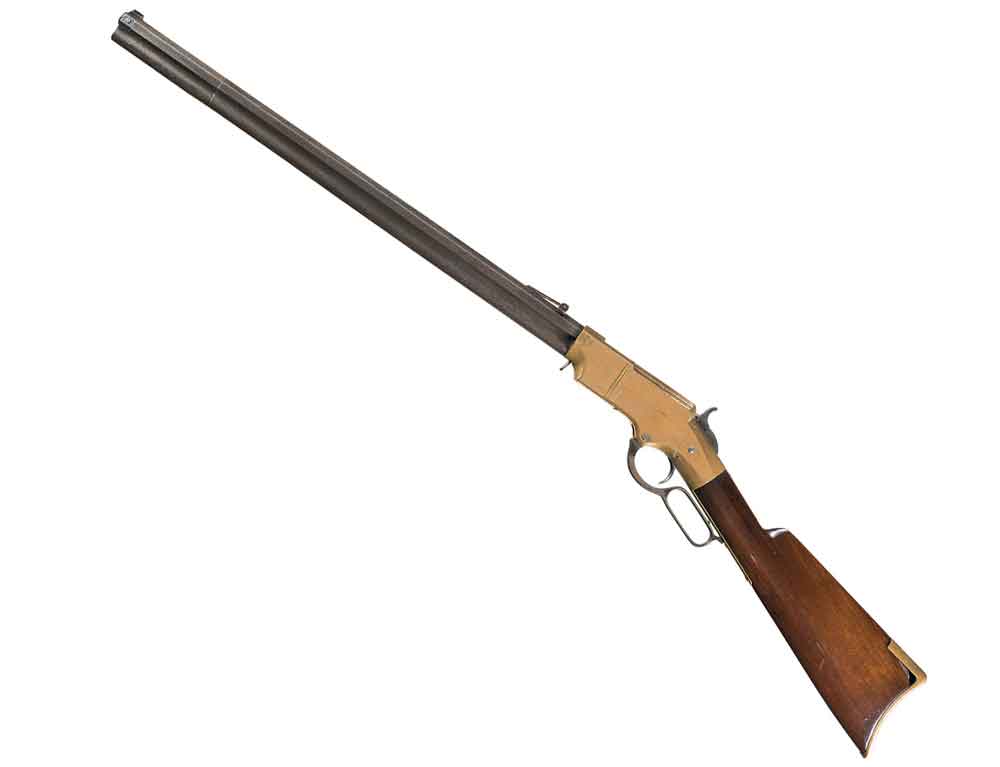
Though limited in use, the 1860 Henry proved itself a wicked weapon in the Civil War. But its devastating effect was perhaps best demonstrated in another heralded American battle — the Little Bighorn.
Armed with the brass-receiver beauties, among other repeaters, Sioux and Cheyenne Warriors utterly devastated the 7th Cavalry. Some archaeological evidence points to 134 firearms in the hands of the Indians, 62 of them Henrys.
The cavalry, on the other hand, was armed with single-shot Springfield Model 1873 rifles firing the now-notorious copper cartridges — known to expand and jam the breech. So it seems George Armstrong Custer and his men weren’t only outnumbered that late June day, they were also vastly outgunned.
Beyond formal conflict, the Henry was a mainstay among many pioneers during westward expansion. Its 15 rounds of .44 Henry rimfire not only proved adequate for protecting a homestead or scaring off cattle rustlers, but also bagging the odd deer.
Colt Single Action Army
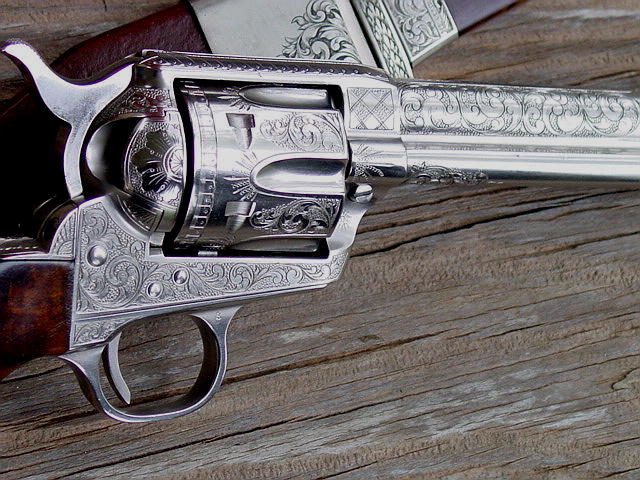
No other gun sums up the Wild West like this Colt. Introduced in 1873 originally as a Cavalry revolver, the Single Action Army spread across the frontier like a prairie fire.
Perhaps no single gun hung off the hips of more cowboys, lawmen and outlaws than this revolver. The likes of Wyatt Earp, John Selman, John Wesley Hardin, Bat Masterson and many others all favored the Colt and for good reason. The revolver was well balanced, provided a fast rate of fire and superior ergonomics. To the last two points, the six-gun's design allowed it to rock back in the hand upon firing, setting the shooter up to cock the hammer for his next shot. On top of that, the Colt SAA packed a wallop, particularly in its most prominent chamberings — .44-40 WCF and .45 Colt.
The Colt SAA wasn’t infallible, however. Slow on the reload and only able to be safely loaded with five rounds (unless an hombre wanted to lose a pinky toe), the gun could quickly be out of the fight and slow to reenter. But in competent hands, and there were many, there was no deadlier weapon on the American frontier.
Colt 1851 Navy
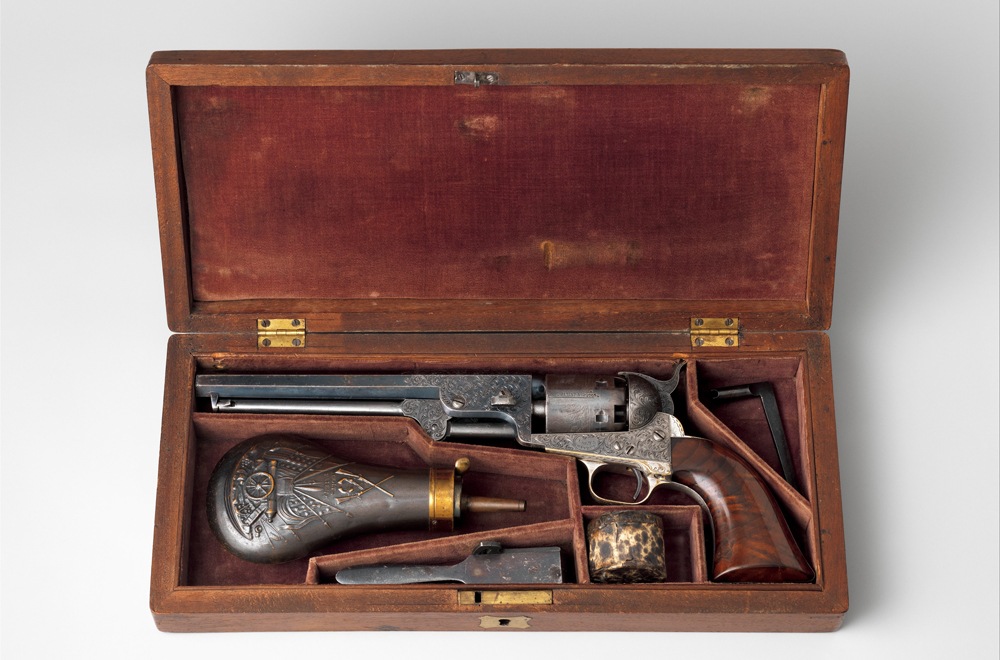
Named for the Republic of Texas Navy, ironically, this gun saw little action on the high sea. But on the vast American frontier, the handsome six-gun was among the most prolific cap-and-ball revolvers. Some quarter of a million were made between 1850 and 1873.
Though on the surface it doesn’t appear so, what made the gun so desirable, aside from its smooth handling and potency, was its portability. Designed as a sidearm, the 1851 Navy was much lighter than similar revolvers — the Walker Colt and Colt Dragoon. In turn, an hombre could easily keep this peace of mind at hand out of the saddle.
In its cap-and-ball form, the Navy was a .36-caliber gun, but toward the 1870s a number of the revolvers were converted to accept .38-caliber metallic cartridges. The 1851 saw prolific use in the Civil War and across the West. Robert E. Lee carried a Navy while serving with the 2nd Cavalry in Texas, and it was the preferred revolver of no less than James “Wild Bill” Hickok.
1873 Springfield Trapdoor
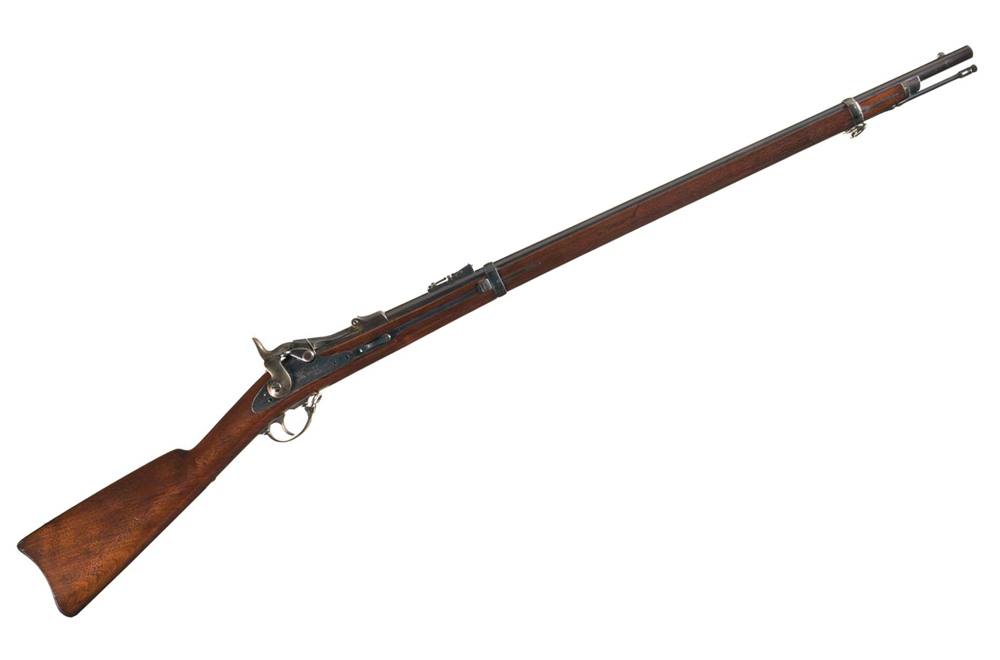
In an age filled with some of the most iconic repeaters to ever drop a hammer, the Springfield Trapdoor seems downright frumpy. The single-shot rifle, however, was among the most plentiful firearms out West.
This is primarily due to it being the U.S. Army service rifle for the better part of the American age of expansion (1873 to 1892). It was a mainstay for both sides of the intermittent conflict known as the Indian Wars and a fairly solid rifle once the bugs were worked out.
Its main sticky point, literally, was the rifle’s early ammunition. The Trapdoor initially shot .45-70 Government ammo loaded in copper cases, which, when heated, expanded and had a tendency of jamming the breech with devastating consequences. Many blame this flaw as one of the reasons the 7th Calvary was routed at the Little Bighorn.
Custer’s last stand prompted the Army into action and eventually to adopt brass cases, which made all the difference in the world. The .45-70 round itself was more than enough to handle anything a soldier set his sights on out to 1,000 yards. And given this potential, the Army began to emphasized marksmanship. Shooting practice and, eventually, competitions became a more regular part of training, preparing soldiers to use the rifle with crack-shot accuracy on the open prairie.
Winchester Model 1873
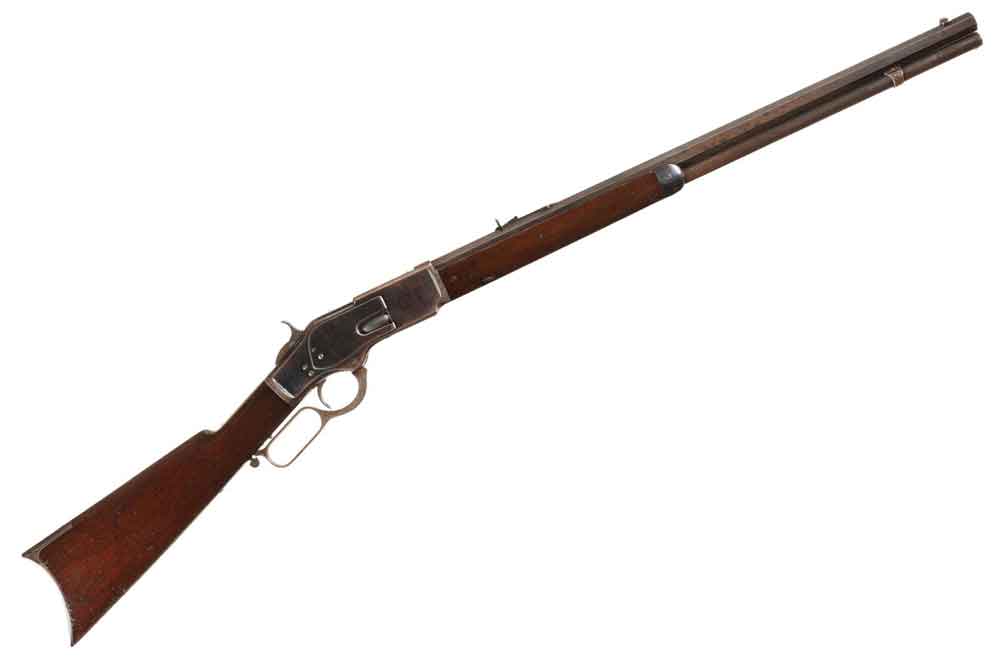
Arguably the most famous and recognizable rifle of the Old West, the 1873 is a true icon of the frontier. The iron-framed, lever-action rifle was ideal in a saddle scabbard or at the homestead, ready to take care of any chore a revolver couldn’t handle. And plenty of good and bad men had chores for the 1873, with the likes of William F. Cody, the Texas Rangers, Billy the Kid, Butch Cassidy and a long list of other Western notables employing the rifle.
In addition to its ease of use and low maintenance, what made the 1873 a success was Winchester chambering it for a number of its proprietary pistol ammunition — .44-40, .38-40 and .32-20. This took a load of burden off a buckaroo during a period when logistics were not at the top of their game. A fella never knew when a desperado might highjack the latest ammunition delivery heading to the local general store thus leave a pistol or rifle high and dry.
The rifle was also awash across the West, with some half-million manufactured before the turn of the 19th Century. Honestly, no self-respecting lawman, rancher or outlaw would be caught without one.
Double-Barreled Shotgun

Certainly, the 1873 Winchester Rifle and Colt Single Action Army were as abundant as tumbleweeds out West; but they most likely paled in numbers to the simple double-barreled shotgun. The firearm was ubiquitous, brought in droves by pioneers heading for new lives in the West.
Double-barreled shotguns came from all corners of the globe, many rolling out of local blacksmith shops. And they made a lot of sense as a tool to tame the land, given their flexibility. Capable of bagging nearly any game known to man — be it covered in fur or feather — the shotgun also doubled as one of the most notorious defensive arms ever to bare a trigger.
There was a good likelihood every lawman had one at hand and they were heavily utilized to guard stagecoaches in their shortened coach gun variation. But the double-barrel shotgun was also the stock-in-trade for some of the wickedest men to roam the West. “Deacon” Jim Miller, for one, cottoned to the brutal instrument and used it to devastating effect on a number of occasions.
Sharps Rifle

While it saw its share of military battles and the odd lawman might have one at hand, the venerable Sharps left its mark on the West in a much different fashion than many of this era's storied firearms — hunting. During the hide-hunting era of the American frontier, the powerful single-shot rifle felled more buffalo than perhaps any other firearm. It was ideal for the task.
Chambered for powerful rounds such as .50-90, .50-110 and .45-70, the falling-block rifle was reasonably accurate, allowing hunters to harvest buffalo at relatively long ranges. This is a black mark against the rifle today, with commercial hunting typically blamed for pushing the prairie behemoth to the brink of extinction.
Even with the ballistics to drop a buffalo more than 1,000-yards out, there is modern research that points more to disease than the Sharps and other big-bore rifles in the animal’s disappearance. Either way, the rifle still had an impact — be it large or small — and today is considered by many as iconic in the West as the Colt SAA and Winchester 1873.
Smith & Wesson Model 3
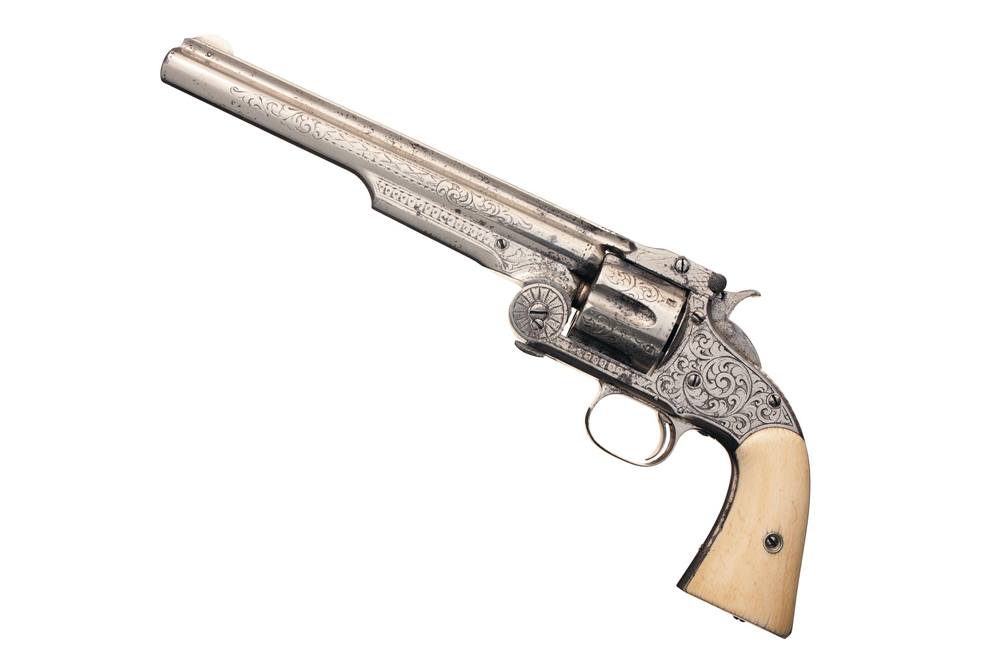
The first revolver that fired metallic cartridges adopted by the U.S. Military, it didn’t take long for this break-top beast to catch on with good and bad men alike. From lawmen like Pat Garrett to outlaws such as John King Fisher, the Model 3 delivered the goods.
Chambered originally in .44 S&W — later in other .44-caliber variants, as well as .38 — the six-shooter offered more than enough power to take care of even the most stubborn adversary. On top of that, it was fast to reload. Opening from the top to expose all six cylinders, a gunslinger could quickly get the single action back into a fight.
This was a distinct advantage in an era where old cap-and-ball revolvers were still prevalent. Even the beloved Colt Single Action Army couldn't beat out the Model 3 since it had to be reloaded one cartridge at a time.
Winchester 1886
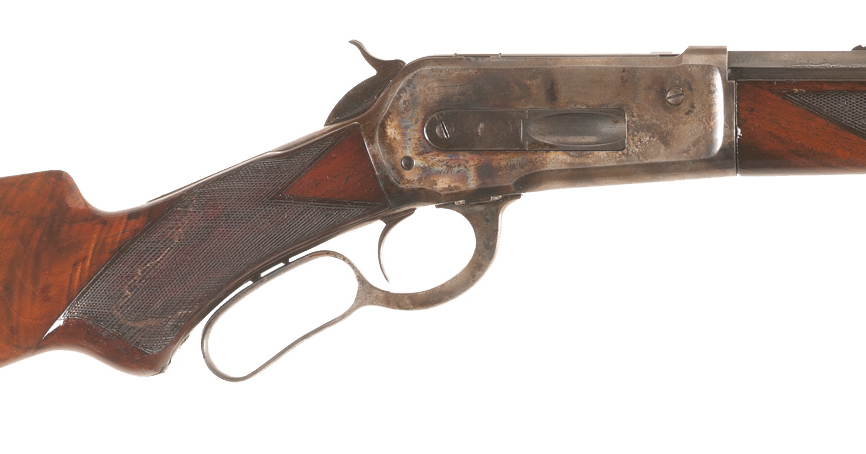
John M. Browning, of course, left a mark on the Old West, perhaps no more so than with his first repeating rifle with Winchester. A stronger rifle than the Model 1876, with vertical locking bolts, the ’86 was also sleeker and easier to handle. And it vastly outgunned the majority of repeaters of the day, shooting some of the most powerful big-game cartridges around (and well) — .45-70, .45-90 and .50-110.
Perhaps best of all, it added a dimension of firepower to the equation with the lever action’s nine-round tubular magazine. In one fell swoop, the single-shot rolling-block rifles were outclassed and obsolete on the hunt. But it wasn’t only hunters who saw the benefit of the massive and powerful Model 1886.
Bob Dalton of the notorious bank and train robbing Dalton Gang is reported to have carried the lever action. And a number of the hired Texas killers — known as the “Invaders” — utilized the rifle in Wyoming’s Johnson County War.

Next Step: Get your FREE Printable Target Pack
Enhance your shooting precision with our 62 MOA Targets, perfect for rifles and handguns. Crafted in collaboration with Storm Tactical for accuracy and versatility.
Subscribe to the Gun Digest email newsletter and get your downloadable target pack sent straight to your inbox. Stay updated with the latest firearms info in the industry.

![Best Concealed Carry Guns In 2025 [Field Tested] Wilson Combat EDC X9S 1](https://gundigest.com/wp-content/uploads/Wilson-Combat-EDC-X9S-1-324x160.jpg)


![Best 9mm Carbine: Affordable PCCs [Tested] Ruger Carbine Shooting](https://gundigest.com/wp-content/uploads/Ruger-Carbine-Shooting-100x70.jpg)
![Best AR-15: Top Options Available Today [Field Tested] Harrington and Richardson PSA XM177E2 feature](https://gundigest.com/wp-content/uploads/Harrington-and-Richardson-PSA-XM177E2-feature-100x70.jpg)
